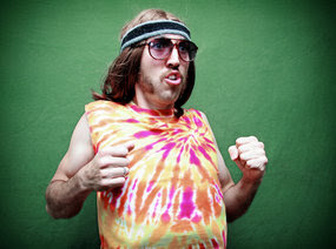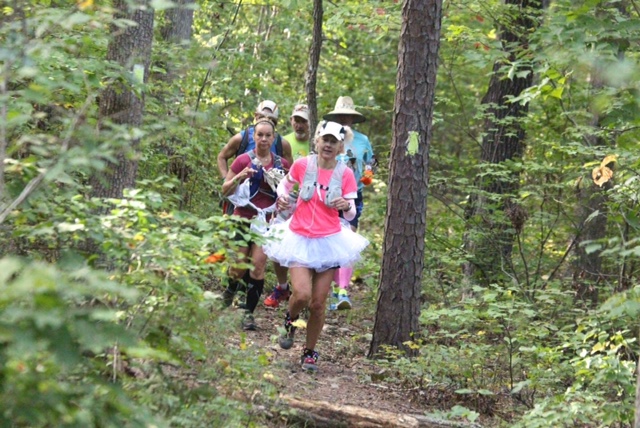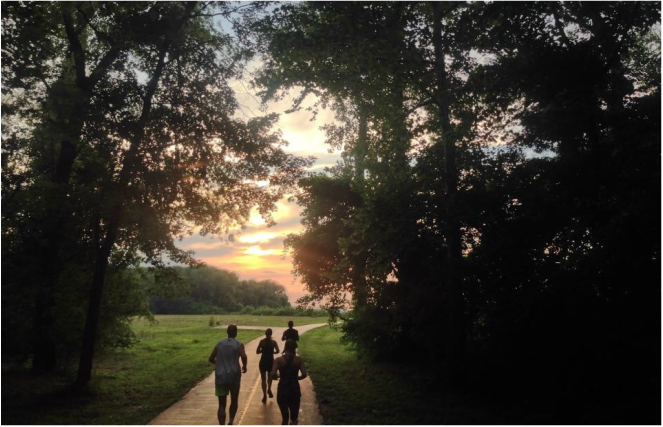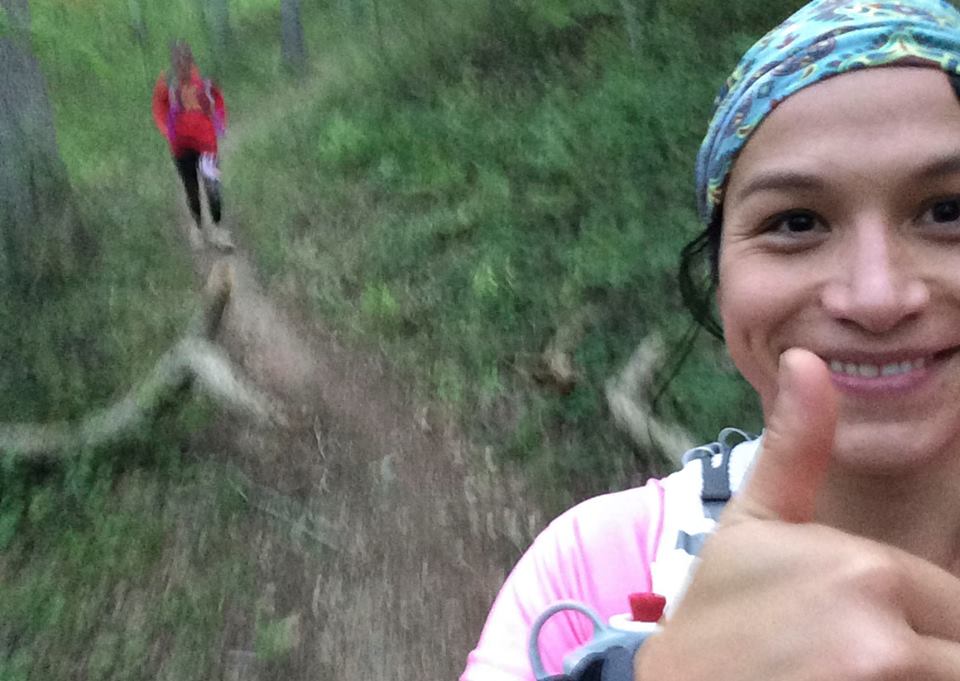 The runner’s high. It’s why we all run, right? Lace up, hit the ground, push our limits for the sweet feeling of…hmm, what exactly is a runner’s high? Have I ever had one? Does the ensuing goofiness after a run count? Was that what happened that one time I hyperventilated? Google “runner’s high” and the most legit definition is very scientific while still lacking any explanation as to whether you’re going to feel euphoric or delirious or even just pretty good. I think it was sometime in college that I realized not everybody ran. So, when I first started sharing my running experiences with others, often over a drink, pre-social media — well, OK, we had IM and Myspace was becoming a thing — I always got the same questions. “Oh, you go for the runner’s high?” “Do you get a runner’s high?” “Heeey, maaan, what’s a runner’s high like?” I always felt weird saying, “Uh, I don’t know.” But that was the truth. Having run fairly regularly since the seventh grade, I never looked at aspects of running as ones that would be considered anything other than a stage of suckiness or a stage of “oh, running, how do I love thee?” As I’ve gotten older, I guess I’ve paid more attention to those swings of emotional high and low that come with running. Running is a great coping mechanism for me. I often make peace with a disappointment or loss through running. Sometimes, though, I unintentionally close a difficult chapter while logging miles. One 20-mile run that I did this year was really just the pits. I had four miles left and, had quitting not meant I was stranded out in a cornfield, I would’ve just stopped. But then I started thinking of a departed friend (and previously accomplished distance runner) and I felt almost as if he were there with me. I was overcome with emotion, started really pushing the pace, and felt a huge weight crush into my chest around the same time I realized that I had tears running down my face. Runner’s high? I’ve had speed days where I feel like I was flying, just really toeing the line of that sub-6:30 mile, focused solely on speed, not even footfalls. Every skin surface tingled, all my muscles worked in unison, the feeling of unhinged strength and ability. This is where I am supposed to be, this is what I am supposed to be doing. I am the shit! Runner’s high? From time to time during steady hill climb, when things start to feel as if I’m just stuck in the same upward motion, I ask myself, “Sheesh, do I really want to be on this hill ALL day?” So, I push it, I stress my heart, turn off the pain receptors in my brain, and go faster, uphill. It’s hard to breathe. It’s touch-and-go as to whether I’ll survive standing up. But as the hill levels, I feel good. Real good. Runner’s high? After a long run, I can label myself as fairly useless for the remainder of the day. Sure, I can handle obligations with farm and family. I can take on a few non-essential tasks, but I’m sure that more than one bystander is like, “Really, that woman forgot how to use her pen.” I might start talking and all of the sudden that quick little tangent ends up being “a thing” that I want to discuss at length and research and potentially invest in. Crazy stuff. I’m often thankful that I’m able to drive without injuring myself or anyone else after particularly exhilarating mileage. Runner’s high? So, let’s discuss. Were any of these runner highs? Well, it has taken me years of running to quantify what exactly MY runner’s high is, and that might not come close to what is expected from another person’s experience. My runner’s high is a kind of gratitude. I’m just so darn thankful for EVERYTHING. It’s most intense while my body is running at a pleasantly sound mode. It sometimes only last a few seconds, but I’m happy to acknowledge it, and I realize it is a little gift (just for me) arrived at due to a little push (from me). I can recall moments over my life where I felt very much in peak form, and this “buzz” feeling certainly accompanies that. But, as for a high, I dunno. Maybe I still haven’t gotten that. I don’t get asked about it much anymore, as I tend to share my experiences and accomplishments via DRC, or with other runners. This way, I keep my poor, extended family from asking questions like, “Eight miles? Oh my gosh, you are going to kill yourself!” or “Oh, I see, you go for the runner’s high.” Author: Meghan McCarrick lives in Washington, Mo., eats copious amounts of kale and runs 30 to 50 miles a week, usually with her dog, Magpie.
0 Comments
They all start out about the same. Laughing, joking, chatting with old and new friends in the dark at the beginning of a very long journey. There are no guarantees as to who will finish. You’re just out there so long, and anything can happen. And usually does.
Arkansas Traveller is a well-oiled machine. I ran the 24th edition of the race, and it lacks for nothing. There are 12,000 feet up and 12,000 feet down on singletrack, forest, jeep and gravel roads. And there’s no shortage of rocks. They come in many varieties of shapes and sizes to keep you company all along the way. Aid stations are spaced no further than 6.6 miles apart, so food, drink and TLC are always close at hand. The first miles tick away in the cool autumn darkness. The sun slowly rises, and a breeze blows gently. I’ve been running with a group for a while and feel great. Aid stations have been offering up pancakes, sandwiches and many other yummy treats. I eat often and a lot. I know eventually my stomach will protest, so I keep the calorie train going. I meet some awesome runners from Texas and hang with them on and off for a while. There are nice rolling hills, and the terrain changes from easy to a bit more technical to keep things interesting. The temperatures rise, and the sun shines bright. It’s a beautiful day. I come and go quickly through the aid stations. At mile 48, Powerline Aid Station, I have my light and warm clothes in a drop bag. It’s not even close to cool, but I wrap a shirt around my waist and shove my light in my pack. The sun will set at 7 p.m., and temps will drop quickly. I know I’ll get cold. I wanted to be at this aid station at 12:30 or 6:30 p.m. I was through at 10:56 a.m. or 4:56 p.m. Saaaaaa-weeeeeeet! I felt happy and continued to run with small groups of runners. Passing through mile 53, Copperhead Aid Station, you start an out-and-back that I find brutal. It’s about a 12-mile push altogether and just seems incredibly long. I make the turn right after dark and activate my headlamp and tutu. I’m starting to have upper back pain, and my stomach is nearing the end of solid food consumption. Arriving back at Copperhead Aid Station, I feel horrible. I need to lie down and throw up. Aid station workers quickly start bringing food and drink. I don’t even get my head down when the Texas runners show up. It goes something like this: “You are not laying down! You’re coming with us!” “I don’t want tooooooo....” They each grab an arm, and I’m up and going. “But...I'm not...ready....” “We’re taking you to the next aid station with us.” So, arm in arm up the hill we go. Max and Butch had each completed the Traveller many times — 10 times and 8 times if, I remember correctly. We walk and trot the 4.1 miles to the next aid station. I want to go with them, but they’re gunning for sub-24 hours and I don’t want to hurt their chances. Instead, I sit for a while, throw up and then have some soup. I need to go because I’m freezing. Quotes and advice play through my head as I put on a warmer jacket and gloves: “It doesn’t always get worse. You’ll feel better soon.” Out into the dark I go. Moving. Slowly. The pain in my back is horrible. I’d been carrying my water bottle in the same hand until then. Maybe that caused it. With this revelation, I change hands and press on. I’d filled my pack with licorice and someone gives me ginger chews. I’m managing about 2 mph but have to stop and vomit about once every 30 minutes. It’s gonna be a long night. Caffeine tabs and red Twizzlers are my diet for the next eight hours. A pacer for another runner picks me up sometime in the dark. He chats. I don’t. The moon shines bright and big through the trees. I pray for a second sunrise. Keep moving. Any pace is better then no pace. A borrowed iPod plays new music and keeps me awake. The night takes its time. Deer run in front of me, and owls hoot in the trees. I enjoy those fleeting moments. The push back over Smith Mountain is long and slow. But I’m moving. I keep finding positives when and where I can. At mile 87 I have a few saltines with peanut butter and a Sprite. It isn’t much, but it’s enough. A half-marathon to go. I start running again and pass a few racers along the way. I feel I’m biding my time with my stomach. I make the last aid station, but can’t eat or drink anything. I realize at that point that my back has stopped hurting. I hug an aid station worker who remembers me from my other Travellers and she says, “You know what you need to do, so go do it!” Only 6.6 miles to go. I could crawl and still make it. I’m really hoping not to have to crawl. As I run down onto the paved road, I can smell the barn. Emotion washes over me. It’s been a long night getting to this point. I cross under the finish banner at 28:03. Happy. Reflections about the race: Was it worth it? YES! Will I do it again? HELL YES! Maybe it didn’t hurt that bad after all, or maybe I just can't remember. Author: Laura Range lives in Oakville, Mo. Ultrarunner, mom and defender of the universe. I mean, really, who gets to have this much fun as an adult?
Sure, everybody likes a solo run. Hit play, tune out the surroundings, wave to fellow runners…if you feel like it. Or blow past them quickly enough that you don’t even have to acknowledge anyone else is out there with you at all. Just me and my mountain or dirt road or four-lane highway. Solo run, I got love for ya. But, there’s a need for that running camaraderie, that pack mentality. To be able to hit a rock wrong and warn the person behind you instead of feeling like an idiot when you look around to check that no one saw. Group run. Just saying, it invokes the anticipation and thrill of stretching your legs, feeling out your leader, playing your roll within the tribe. Stretching it out in the beginning, talking about the latest conquests, hitting those first (often uncomfortable) steps as a unit, warming it up, pulling out the stops, helping each other along the way, racing to the end, and finally a finish of delirious contentment. Runners know how to tap into that childlike bewilderment and that untethered push, where we don't feel pain or limitation or obligation. Group run. Your chance to feel whole. When I think, “Let me sing to you the song of my people,” I hear grunts, run steps, slipping gravel, rustling leaves. I schedule these runs for myself as much as anyone else. Some runs are on challenging singletrack trails, some on winding dirt-packed forest floor, a few along rail-to-trail and once a month, through town. I cherish the opportunity to have access to invite “my people.” Turnout is typically between eight and 16, and the consensus is always that “this was the best time ever.” It doesn’t matter if we have a fall along the way or gear failure or sore muscles or a run-in with a wild beast. Always, the sense of tribe is the end result. Your filter is removed when you push yourself physically, and what you’re left with is honesty. “This is as fast as I go.” “This is as far as I go.” “I’m going to throw up.” The people I run with probably have better insight as to who I am and what I can take at the core than members of my own family. A group run is a thing of stress and worry for me a few days or hours beforehand. Not only do I feel jacked up by the whole process, I simultaneously feel tired and anxious and kind of like I’d rather do something else. Weird stuff. Within the first few seconds of hopping into the car, I decompress and feel that everything is right with the world. I leave the stresses of home behind and realize THOSE were the weights that made me think the run was a problem. I sometimes have to crack a window just to keep sweat at bay. I crank up the stereo and think over whatever gear I might need to pull out of my ever-ready run bag, a fixture in the trunk, when I arrive. As I drive closer, the music is turned down, and I find supreme focus. My dedication to these runs never ACTUALLY waivers, but it’s very much just a piece of a clustered life. When I schedule, prepare and even struggle getting my shoulders through the teeny-tiny openings of a sports bra (you know what I’m talking about), these are all just more “means to my ends.” The kids’ voices never stop, the need to have everything prepared for myself AND for abandoning the household, those are all weights that I get the opportunity to run out from under for that hour or two. Group run. Where you shed the preconceived notion of individual and find your place amongst a mass. I think a lot of people race for this very reason. That united feeling of fatigue and exhilaration is unlike anything you can experience otherwise. So, group run. Go find your people. On a whim, albeit a strong one, I found my people at a trailhead in a strange place just before dark. I wasn’t sure if I’d even be able to keep up. It has changed my adult life. I never had this kind of fun at a bar or home watching TV or even vacationing. Group runs give me “self recharge” and primal recognition to my part in the whole. If you don’t run, start. If you do run, group run. At least once a month. Author: Meghan McCarrick lives in Washington, Mo., eats copious amounts of kale and runs 30 to 50 miles a week, usually with her dog, Magpie. We were sitting by the campfire in foldout chairs at two in the morning when a quick glance toward the woods caught my attention. Headlamps, moving fast. As a group, we all strained our eyes and slowly rose from our chairs until someone said, “The winner. IT’S THE WINNER!”
Two headlamps blazed up the trail and, as they approached the finish line, a feeling of excitement, accomplishment and extreme emotion fell over those of us still awake and waiting for our racers. The winner of the Mark Twain 100 had just finished 100 trail miles in 20 hours and 19 minutes. His pacer fell in right next to me, reached for his knees and panted out the words, “I’ve never seen anything like it. Incredible!” So, what exactly is a pacer and what is pacing? Essentially, pacing is the use of secondary runners to keep an efficient and consistent pace. Some say pacing is strictly “muling.” Others think of pacing as an insurance policy. (I’m being totally honest when I say my MT100 racer said multiple times pre-race, “Please, Meghan, just don’t let me die.”) The answer to “what is a pacer” is more difficult. It takes a certain type of runner to veer off before crossing the finish line and forgo the glory of a medal. For a seasoned pacer, that thought probably doesn’t even register. For a newbie, it could be a bit of a mind-blower. If you’re curious about breaking into the strange and wonderful world of ultra running, if you know that you can depend on yourself and that a running peer with a goal can depend on you, consider pacing. Whether you quietly leave footfalls for your runner to follow or act as a one-man show (tying shoe laces, filling hydration bladders, replacing batteries and making food choices at aid stations) the point is merely to be reliable. Pacing offers an amazing opportunity to learn about your own capabilities in distance racing. I’d venture to guess that most pacers, especially at the professional level, do compete regularly and often use pacing as a training run. That isn’t always the case, though. I’m very forthright in saying I have no racing aspirations. When you get down to it, basic conditioning and sound accountability are the important qualities. Great pacers sing, ask trivial pursuit questions, record the whole event and present to their runner a video complete with musical accompaniment, credits and bloopers. All that is bonus material, and THAT pacer deserves a raise. Pacing is akin to babysitting a super athlete: listening to your runner, offering them everything you can and getting their ass across the finish. To do that, you have to want it badly for them. You have to erase any thought of not finishing. You have to put your own needs aside. I’ve always begged non-running friends to come out and hit a trail with me. I’ve latched onto regular runners for dear life and found joy in their announcement of “Well, there’s a new PR.” I’m flexible in pace and distance; I don’t give a damn about winning for myself. I find so much pride and enjoyment as an advocate for others’ goals that pacing just feels natural to me. I joke when I say professional pacing is my calling and the current direction of my “career path.” But, in actuality, I kind of see that as the perfect (although unpaid) dream job. After the winner of the MT100 crossed the finish line, my anticipation level would best be described as euphoric. I was elated that I’d soon get to hit the ground running and delighted to be part of this crazy ultra-marathon experience. My runner was expected at any minute, and there was one more 25-mile loop to conquer before she would complete her race. So what if it was 2 a.m., below 40 degrees and we were all standing around in a parking lot looking off into the woods? We all knew the importance of being there. The winner’s pacer, his job complete, threw on a hoodie and walked back over to where I was standing. As we stared past the lighted beacon of the finish, all I could think was, “Oh my gosh, I get to be part of this!” We both grinned embarrassingly at one another. We were pacers, and we loved it. Author: Meghan McCarrick lives in Washington, Mo., eats copious amounts of kale and runs 30 to 50 miles a week, usually with her dog, Magpie. I never really thought much about having a crew and/or a pacer until I signed up for my first 100-miler. However, I have stepped up to the start line at a few races and thought to myself, “How am I going to get in and out of the aid station at 45 miles when I’ll barely be able to bend down to change my shoes?” (And, let’s face it, this is probably the least of one’s issues at that distance.)
When I’d get to the aid station, though, there would always be a friendly face — in most cases that of a stranger. “What can I do for you?” “How can I help?” “What do you need?” He or she would refresh my water and fuel, get me something to eat and, yes, even bend down and lace up my shoes for me. This is the undeterred camaraderie of trail and ultra races. This is also the reason why I personally wouldn’t entertain a pacer for a distance under 100K. But when do you need a pacer, or do you need one at all? Talking to a number of ultra running friends and acquaintances, I’ve learned there are two schools of thought on the subject. Let’s take a look at both sides. The Case Against a Pacer It’s an endurance race, and you’re supposed to do it alone, using your own strengths and abilities. The challenge lies in beating your body, your mind, the trail and whatever Mother Nature throws at you. The purity of the adventure. The solitude of solo distance running. Isn’t that why you signed up for the race in the first place? It’s because of this “all-or-nothing” mindset that many runners decide to forgo pacers. In some rare cases, your pacer has a bad day or is unprepared and needs assistance. So, guess who ends up being the babysitter? At this point, do you worry about your race or do you worry about your pacer? Do you really need that distraction, especially at a distance over a 100K, when time gets fast but everything else gets slow? Some racers argue they can just as easily find another runner on the course that they can pace with, so why bother with another body on the trail? It’s not unusual for some ultra distance runners to become grouchy or withdrawn when they’re “in the zone,” and this can become an issue as the miles add up and pain and fatigue set in. Aggressive energy could ruin a relationship between a runner and his or her pacer. The most common thing I heard was, “I’m not racing for time, so what do I need a pacer for?” Some even argue that the use of pacers is like being hand-held along the course. If the pacer weren’t there, would the runner be moving along at the same rate? Clearly, they’ve got someone else doing the thinking for them. The Case for a Pacer The harder the race is, the better your case for having a pacer — and the better your overall chances for success are, no matter your goal. I can’t speak to the exact stats for runners finishing 100-mile races with pacers versus those without, but I’d be willing to bet it’s a big difference. And even if a runner finishes an ultra without a pacer, they probably would’ve finished with a better time and had a lot more fun had they used a pacer. When you bring on a pacer after 50 miles of solo running, it’s not so he or she can hold your hand. Nor is a pacer a dog or a cat that’s there for companionship. A pacer keeps you safe. He or she is of sound mind and body. Trail conditions can be hazardous at the best of times, and when you’re running in a state of delirium, that snake on the trail can look like a cool stick that you just have to stop and pick up. There’s truth in the saying “safety in numbers.” In a pacer you have someone who focuses on your personal finish goals when perhaps you can’t. A smart pacer will zero in on signs of distress when a runner might be struggling. They will look for fluctuations in pace, dexterity and general energy levels. They will keep the runner eating and drinking even when their appetite is shot. A pacer can help you push through the pain and overcome those mental blocks that occur beyond 50 miles. They can think logically with their head — instead of with their heart, like a disoriented runner — when important decisions need to be made during a race. A pacer also understands how to capitalize when a runner is feeling strong, pushing the pace and the positive emotions. Final Thoughts So, should you use a pacer or not? Well, the simple answer isn’t so simple — it’s really just a personal choice. In my opinion, no matter what your goals are, you should take advantage of every way to get to that finish line as quickly as possible. I don’t agree with the “all-or-nothing” approach, and while not all 100-mile races will require a pacer, I think that for certain races a pacer can be critical. However, I also disagree with the statement that “a pacer can make or break your race.” In the end, it’s your run and yours alone. Others can run it with you, but no one can run it for you. Looking back at my first experience with pacers at the Mark Twain 100, I fully enjoyed it. The laughs, the stories, the pain, the success — none of it would’ve been the same had I not gotten to share it with my fabulous girls (you know who you are). So, for me, I say “yes” to pacers. Author: Shalini Kovach is a trail junkie and ultra distance runner living in Ballwin, Mo., and is the lead organizer of Terrain Trail Runners. |
AuthorsOur blog writers are members of Terrain Trail Runners, local athletes just like you, who want to share their love and knowledge of the sport. Archives
March 2023
Categories
All
|





 RSS Feed
RSS Feed